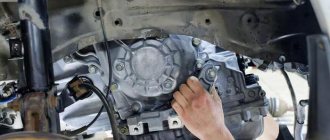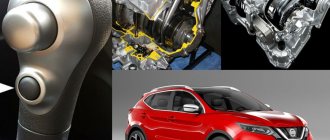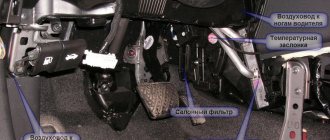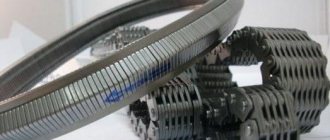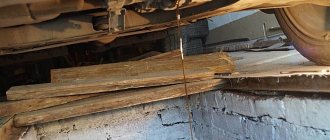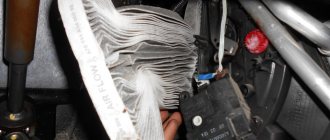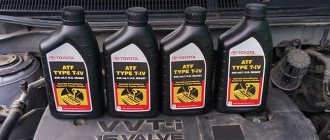Many popular modifications of the Nissan Qashqai have been and continue to be equipped with a CVT transmission from the Japanese company Jatco. The first generation crossovers, depending on the engine, were equipped with CVTs JF011E and JF015E. Engines of models after 2013 were combined with JF016E and JF017E transmissions. The JF010E (RE0F09A) variator is designed for powerful engines. If the first models of CVTs were not reliable, the latest versions have proven to be quite practical and repairable units. They work effectively with both naturally aspirated and turbocharged engines.
| Crossover generation | Year of issue | Engine | CVT modification |
| 1st generation Nissan Qashqai J10 | 2006 – 2013 | Gasoline 1.6 l | JF015E (RE0F11A) |
| Gasoline 2.0 l | JF011E (RE0F10A) | ||
| 2nd generation Nissan Qashqai J11 | 2013 – 2021 | Diesel 1.6 l | JF017E |
| Gasoline 2.0 l | JF016E | ||
| Gasoline 1.2 l turbo | JF015E (RE0F11A). | ||
| 3rd generation Nissan Qashqai J12 | from 2021 | Hybrid 1.3L turbo | JF022E |
The continuously variable transmission provides smooth gear shifting without the use of standard gears. The advantage of CVT is driving comfort and fuel efficiency.
The automaker provides a 5-year or 150 thousand km warranty on the CVT transmission, subject to the restrictions and recommendations for operating the unit. If your car is not covered by warranty service and repair, then contact our company. Masters will perform all operations competently and at a high quality level.
Characteristics of CVTs
| Transmission | Drive unit | Engine | Torque | Resource |
| JF010E (RE0F09A) | Front/Full | up to 3.5 l | up to 350 Nm | 250 thousand km |
| JF011E (RE0F10A) | Front/Full | up to 2.5 l | up to 250 Nm | 200 thousand km |
| JF015E (RE0F11A) | Front/Full | up to 1.8 l | up to 160 Nm | 160 thousand km |
All Nissan Qashqai CVT transmissions have an identical design with a Bosch belt and a 14-valve valve body. Only some mechanical components differ, made with reinforcement to ensure high torque.
The JF011E variator was developed in 2005 and was installed on many modifications of the Nissan Qashqai. Has a classic design. The force between the pulleys is transmitted using a belt. Changing the position of the cones to select the gear ratio is carried out using a stepper motor.
The Nissan Qashqai JF015E continuously variable transmission was introduced in 2010 to work with small engines. Transmission features: two-stage planetary gear, smaller pulleys, reduced weight and dimensions, control solenoids in the valve body.
The JF010E variator was installed on Nissan models from 2002 to 2017 with high-power engines. The transmission features reinforced mechanical components and a high-performance gear oil pump.
Typical malfunctions of the Nissan Qashqai continuously variable transmission that require repair:
- Strong noise (hum, whistle) when the transmission is operating - wear of the cone bearings.
- The oil pump does not work - failures during acceleration, the car may stop.
- Belt slipping on cones - vibrations are felt during acceleration.
- The valve body is defective - the speed begins to fluctuate, the car accelerates jerkily.
- Control unit errors - problems with sensors, valve defects.
These breakdowns and the need for repairs arise due to the driver’s failure to comply with the restrictions and rules for operating a car with a CVT:
- Failure to comply with transmission lube and filter replacement intervals.
- Using non-certified oil.
- Sports driving style: sharp acceleration and emergency braking.
- Long-term operation of the engine at maximum speed (moving at maximum speed).
- Frequent collisions with curbs and other obstacles causing shock to the suspension.
- Natural wear and tear of parts and components. Resource development with high mileage.
Bearing wear
This is the most common defect in CVT cones. It manifests itself with a characteristic hum after a run of at least 50,000 km.
The belt is assembled from numerous plates interconnected by steel constrictions. With its side surfaces, with subtle oblique notches applied to improve adhesion, it comes into contact with the pulley cones. During operation, the notches wear out, which can ultimately lead to serious damage. Therefore, even the elimination of humming bearings should be accompanied by a preventive replacement of the belt, which guarantees the preservation of serviceable pulleys.
Bearing noise can also occur for several other reasons:
There is no consensus among manufacturers on this issue. For example, Mitsubishi strongly recommends changing the oil every 75,000 km, while Renault-Nissan only allows monitoring its level and condition during the warranty period (100,000 km).
CVT oil is marked with the abbreviation CVT. Every car manufacturer has such oil. The original composition from Nissan is produced under the symbol NS-2. Mitsubishi is promoting the DiaQueen CVT-J1. The analogue from Renault is known as ELFMATIC CVT. Honda produces HMMF and CVT-F, VAG produces ATF CVT. All these fluids are recommended specifically for CVTs. It is absolutely unacceptable to use oils intended for hydromechanical automatic transmissions.
The amount of oil required for filling is determined by the type of drive and power unit. For example, for a front-wheel drive Qashqai with a 2-liter engine not equipped with an oil cooler, approximately 4.2 liters are required. A couple of liters will “get stuck” between the transformer elements and the hydraulic system components, since it is impossible to pump out these “drops” using the standard draining procedure. To completely renew the filling, they use the replacement method, using an appropriate installation and three times the volume of working fluid.
Self-check of the variator performance
To independently diagnose a CVT transmission, it is necessary to carry out preparatory work:
- Warm up the engine and gearbox by driving a short distance.
- Check the voltage at the battery terminals (must be at least 12V).
- Disconnect current consumers inside the car.
- Turn off the alarm if there is a break in the standard power supply.
- Place the variator lever in the “Parking” position.
Checking the technical condition and the need for repair of the variator can be done in the following sequence:
- Quickly turn the ignition on and off twice.
- Leave the ignition on.
- The CVT warning light should come on for a few seconds and then go out.
- Turn off the ignition.
- Apply the brake and switch the variator lever to the “Drive” position.
- Turn on the ignition.
- Release the brake and move the selector lever to the “L” position.
- Press the brake and accelerator pedals at the same time. Move the selector to the “Drive” position.
- Release the pedals.
Self-diagnosis starts. The light on the instrument panel begins to blink with short (0.5 sec.) and long (1 sec.) flashes, the combination of which determines the nature of the malfunction and the need for repair.
If the variator goes into emergency mode while the car is moving, then the step motor is checked. You can connect to the motor winding at the variator connector, which is located under the battery. This connector is used to diagnose the transmission electronics. The activation of emergency mode after warming up indicates a malfunction of the rotation sensors. When the continuously variable transmission slips, the pressure in the port and the voltage supplied to the pressure sensor are checked.
In “garage conditions”, you can check the serviceability of the Nissan Qashqai CVT transmission without special equipment only by visual inspection. Independent repair of a unit that is complex in design and operation can lead to an erroneous diagnosis of a breakdown and further expensive repairs of the variator.
To diagnose the electronic control unit, as well as troubleshoot mechanical components and parts, it is better to contact our specialists. For clients who decide to use the services of our auto center for CVT repair:
- It is possible to perform free diagnostics of the unit using computer equipment.
- Accurate determination of the nature of the malfunction and the feasibility of repair.
- Competent troubleshooting of mechanical components.
- Checking the correctness of the control unit algorithm.
- Repairs are carried out quickly and inexpensively.
- The correctness of the work performed is guaranteed.
Consequences of ignoring problems
If you do not pay attention to the symptoms indicating the need for repair of the Nissan Qashqai CVT, serious problems may arise:
- The crossover loses power and acceleration dynamics.
- Gears stop shifting.
- Knocks begin to be heard in the gearbox.
- When slowing down and stopping at a traffic light, the car stalls.
- As the driving speed increases, extraneous noise from the continuously variable transmission increases.
Considering the high cost of spare parts, it is beneficial not to cause problems, but to carry out repairs immediately. Delaying repairs will lead to complete failure of the variator.
Possible causes of malfunction
Possible causes of such a breakdown according to code P0826 are presented in the table.
| Cause | Details |
| Gear shift problems | The PCM signals incorrect operation of the downshift/upshift switch connected to the general system wiring circuit |
| Incorrect operation of the device that controls the modes | Equipment malfunctions occur when changing the speed control mode |
| Damage to wiring | Breaks, corrosion, oxidation of contacts in the general circuit |
When to carry out scheduled repairs
To ensure trouble-free operation of the Nissan Qashqai CVT and increase the life of the continuously variable transmission, it is important to comply with the service deadlines. The oil and filter element must be changed every two years or after 60 thousand kilometers. It is recommended to fill the variator with only original lubricant to avoid repairs. When changing the oil, it is necessary to clean the magnets and pan from metal particles.
The operation is performed carefully so that metal shavings do not get into the transmission oil. Repair of the Nissan Qashqai variator, which involves replacing the bearing, depends on the operating conditions of the vehicle. On average, replacement will be required at a mileage of 100 thousand km. If the operating rules are violated, critical wear of the bearing can occur even after 50 thousand kilometers.
Thermal mode
The temperature regime in CVTs should be observed especially carefully. This function is assigned to the self-diagnosis system and is carried out using a temperature sensor. If the limit value is exceeded, a fault signal lights up on the dashboard with the simultaneous transition of the variator to an emergency state.
In order to ensure optimal oil temperature, on most cars, in addition to the main heat exchanger, another radiator is connected. It is mounted in the front area of the engine compartment up to the climate system condenser. Through the air ducts located in the bumper, it is often clogged with various debris - poplar fluff, leaves, dirt, gravel, midges, etc. The first manifestation of its critical contamination is severe overheating when traveling at high speeds. Once every two years it is necessary to clean and wash it very thoroughly. It's best to have the bumper disconnected. It is also recommended to cover the external entrances of the air ducts with protective nets, since the radiator is susceptible to damage from anything that flies from under the wheels.
According to the collected statistical data, failures of variators occur no more often than failures of hydromechanical units. Even the most cautious manufacturers, who were previously quite skeptical about the reliability of CVTs, began to use them in the power units of their popular models. For example, Toyota - on the restyled RAV4, Subaru - on Forester, XV and Outback. The owners of this brand can hardly be called slow drivers. Constant driving over rough terrain and powerful accelerations were recently considered unacceptable for the operation of CVTs. It seems that times are changing, so the prospects are brighter for them.
Source
Nissan Qashqai CVT repair
Based on the color of the drained oil and the presence of metal shavings on the magnets, one can conclude about the degree of wear of the components of the Nissan Qashqai variator and the need for repair. A humming sound coming from the gearbox indicates the presence of a large amount of wear products, which makes it difficult for the pump to pump such lubricant. The repair is carried out in stages:
- The variator is removed from the crossover and disassembled.
- Troubleshooting of parts is carried out.
- If there are burrs on the cones, the surface is polished.
- Deformed and heavily worn parts must be replaced.
- When variator spare parts wear out naturally, they must also be replaced.
- The integrity of the clutches is checked. Those that are burnt are immediately replaced.
- The valve body solenoids are being replaced due to metal dust.
- If there is scoring, the pump valve must also be replaced.
- Assembly after repair and installation of the unit on the car.
Smooth ride
The next most common defect occurs in the form of jerking and jerking of the car. The responsibility lies with the pressure reducing valve located in the oil pump.
The latter begins to function when the engine starts. The pump is manufactured as a monolithic unit and in the event of a defect in the pressure relief valve, it must be completely replaced. During normal operation, the valve should move freely in a mating sleeve pressed into the pump housing. Constant contact of the valve working surface with abrasive particles of wear products falling on it leads to the formation of many longitudinal scratches. When worn, the valve begins to jam so much that subsequently it is difficult to pull it out even with pliers.
The result is abnormal pressure, leading to disruption of the coordinated operation of the pulleys. This causes the belt to slip. Timely contacting the service allows you to reduce financial costs. Minor damage to the cones can be corrected by grinding. The belt must be replaced.
The most famous CVT oil sold in car dealerships is the product from Nissan NS-2 in a two-liter tin. The container of the new issue is silver, the old one is painted blue. In no case should it be confused with the old, completely incompatible NS-1 oil, bottled in pink containers.
Extreme enthusiasts who are accustomed to pulling out a stuck car by rocking with instant alternate switching of the lever from position D to R and back run the risk of encountering another problem - unpleasant jolts during the process of switching from the “parking” position to D or R. In this mode, there is practically no pause when switching. between positions D and R, although ideally a complete stop of the car is required. As a result, increased wear of the coupling spline joints inside the planetary gear in contact with the friction discs occurs. The result is the need to replace the planetary gears.
Cost of work
| Work performed | Average cost, rub | Note |
| Replacing the variator | 18000 | No price per unit |
| Belt replacement | 16000 | Belt cost included |
| Changing transmission oil and filter | 3000 | No consumables |
| Valve block repair | 18000 | |
| Dismantling/installation of the variator | 12000 | |
| Torque converter repair | 5000 | |
| Replacing the step motor of the variator | 3000 |
Diagnostics of the Nissan Qashqai variator is free, provided that repairs are carried out.
Prevention
Following the recommendations of experienced drivers and car manufacturers will allow you to operate the Nissan Qashqai CVT for a long time without repair:
- When the first signs indicating a breakdown of the variator appear, you must immediately contact specialists to diagnose and repair the unit. The sooner the problem is solved, the cheaper it is to repair a high-tech gearbox.
- The level and quality of transmission oil matters for the service life of the variator. It is necessary to change the lubricant and filter element in a timely manner. Use only original oil.
- Driving a car with a CVT should be calm without sudden acceleration and braking. Avoid city traffic jams if possible. Do not drive for a long time at maximum speed. Do not rev the engine to maximum speed.
- Use a car with a CVT mainly for driving on good roads. Drive on a country road at low speed. Avoid potholes.
- Avoid wheel slipping off-road, in snow or drifting on ice.
- Do not tow a trailer whose actual weight is more than 0.5 tons.
- Do not tow another vehicle or pull a stuck vehicle out of mud or a snowdrift.
- Constantly monitor the engine temperature to prevent transmission overheating and expensive repairs.
- On a cold engine, avoid high speeds until the power unit and variator warm up.
Modern scanners
Launch CReader V
Car scanners are devices whose task is to detect a malfunction. The electrical appliance market offers devices designed for a specific car brand. There are also universal options.
Control over the engine is provided by the OBD-II standard, with which the popular Launch CReader V device works. Text information about problems is displayed on the LCD display, and the scanner can also create graphs. Thanks to this, the driver monitors the parameters of the internal combustion engine (for example, air consumption when the engine speed changes). Users note the cost of the auto scanner, accuracy, and intuitive interface. The disadvantage is that it is limited to the specified standard.
ELM327
Cheap diagnostic devices of Chinese origin are more often found under the name ELM327. The prototype was developed by an American company and is designed for professional diagnostics. Chinese analogues connect to smartphones or PCs via a USB port or via Bluetooth. Among the advantages of the scanner are an abundance of diagnostic programs for devices based on Windows OS, Android and IOS, low price, and ease of connection. The downside is the amateur level software. The device is also unsuitable for recoding a car's ECU.
Autocom CDP Pro
Another device is the Swedish prototype Autocom CDP Pro and its cheap Chinese analogues. Clones are not inferior to the original in terms of the abundance of diagnostic functions; difficulties arise when updating the software (Chinese updates, so diagnostic efficiency is reduced). An easy-to-use scanner, as users note, often breaks down.
Replacing the variator
The first CVT transmissions were not reliable, often required repairs and created many problems for Nissan Qashqai owners. Modern CVTs have eliminated the shortcomings of previous modifications and, subject to operating rules, they can operate for up to 200 thousand kilometers without repair. But, if low-quality oil is used, service intervals are not observed, and minor repairs are delayed, the continuously variable transmission can suffer serious damage. In this case, repairs will be very expensive.
Therefore, we recommend carrying out diagnostics and troubleshooting of the unit to determine the degree of wear of components and an objective assessment of the technical condition of the unit. The data obtained allows you to make a decision on the feasibility of repairing the gearbox. In some cases, it is cheaper and faster to install a new CVT. Our experts will help you choose the optimal gearbox for Nissan Qashqai.
Replacement with automatic
Some owners of Nissan Qashqai, especially the 1st generation, who are faced with problems and repairs of the continuously variable transmission, not wanting to further comply with many restrictions, are thinking about replacing the CVT with an automatic transmission. Automatic transmission, when compared with a CVT, has advantages:
- Increased wear resistance and reliability of electronic and mechanical components.
- Less wear and tear with sporty driving style.
- Provides the ability to confidently move off-road.
- Allows you to load the car more and tow a trailer.
Disadvantages include higher fuel consumption and slightly worse ride comfort. If the Nissan Qashqai engine is structurally compatible with an automatic transmission, then our specialists will quickly and correctly replace the gearbox.
